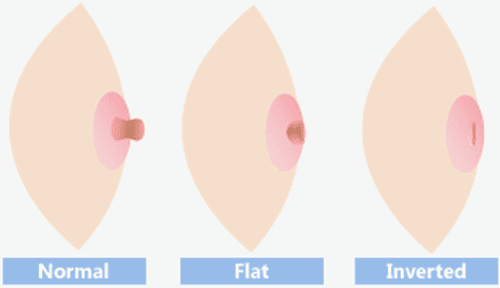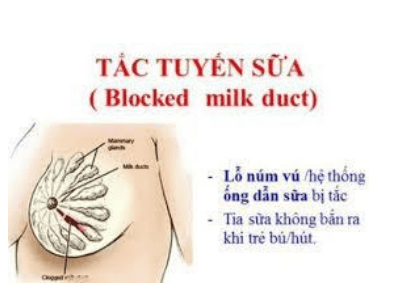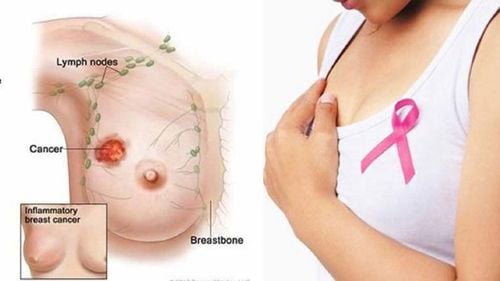This is an automatically translated article.
The article was professionally consulted by Doctor Hoang Thi Anh Tuyet - Department of Obstetrics and Gynecology, Vinmec Central Park International General Hospital.Blocked milk ducts can happen at any time after giving birth. However, it is most common in the first week. About 15% of breastfeeding women experience breast engorgement, engorgement, sometimes also blocked milk ducts with fever or blocked milk ducts into hard lumps.
1. What is blocked milk duct?
Blocked milk ducts are quite common in inexperienced mothers after giving birth for the first time. A blocked milk duct is a condition in which breast milk is trapped inside the milk ducts in the breasts. This phenomenon can make breastfeeding as well as pumping to store milk difficult and painful.
Although blocked milk ducts are not life-threatening, if not treated promptly, it can lead to many serious health problems for the mother, such as mastitis which can cause infection or a very painful breast abscess. hazardous. Over time, breast abscesses become fibrous bands or fibroadenomas of the breast. In addition, blocked milk ducts also affect the milk production process, gradually the mother will lose milk, forced to stop breastfeeding and have to feed the baby with formula milk.
2. Time often occurs blocked milk ducts
A few days after giving birth, the mother feels her breasts are hot, heavy and hard. Milk begins to be secreted as milk ducts in engorged mammary glands that feel like lumps, although milky secretions are still released. This is the phenomenon of engorgement that usually occurs on the 2nd or 3rd day after birth. If not intervened in time, blocked milk ducts can make the mother susceptible to infections, fever, postpartum depression ...

Tắc tia sữa không được can thiệp kịp thời có thể làm cho mẹ bị nhiễm trùng, sốt
3. Symptoms of blocked milk ducts
The first sign of blocked milk ducts is when touching the breast, the mother feels one or more hard spots. The breasts are firmer and larger than usual, the degree of tightness is increasing gradually, the feeling is painful and there is no milk secretion or little milk, not expressed. Milk is not secreted or produced very little, even when the mother actively expresses milk. A few cases of mothers with blocked milk ducts have fever or blocked milk ducts with hard lumps if the milk has accumulated a lot inside. The early opening of the duct will reduce the disease and limit the consequences of long-term obstruction.
4. Treatment of blocked milk ducts

Với tắc tia sữa thì cần dùng các biện pháp vắt sữa để thông tia
With blocked milk ducts, it is necessary to use measures to clear the breast (can express breast milk by hand or use a breast pump), when the milk duct will stop fever, avoid inflammation and create an abscess without using antibiotic. In case of long-term blocked milk ducts that become severe infections in the mammary gland or the wall of a mammary gland abscess, systemic antibiotics (injection or oral), if not cured, must be combined with extracting pus after taking antibiotics. .
In case the mother has a high fever with blocked milk ducts, the breastfed baby will have digestive disorders (faeces with foam, green matter, even diarrhea if the milk contains pus). Therefore, during the treatment of blocked milk ducts with high fever, the baby should not be breastfed on the sick breast, but need to remove it until it heals before re-feeding. Prevention of inflammation and breast abscess is not to block milk ducts. When the nipple is cracked or scratched, aggressive treatment is needed.
In the case of blocked milk ducts with hard, uncomfortable lumps in the breast, you should feed your baby many times to pump out some milk, or use your hands to gently express milk, combined with warm compresses on the breast to help clear the milk ducts. , gently massage your breasts while your baby is nursing or pumping milk. In addition, experts also encourage you to rest a lot, add more water to milk secretion more regularly.
If after a few days, blocked milk ducts with hardening continue, you should use 1 hand to press the breast against the chest wall or use 2 hands to press together. Both pressing and rubbing will melt the frozen milk positions located deep in the breast, slowly in a circle, increasing gradually, about 20 times, then do the opposite, do many times. On the other hand, both day and warm compress on the breast, can be used in combination with a breast pump to pump out milk.
In case you have tried the above measures but the situation is not improved, you need to go to the hospital for timely examination and treatment by a doctor, to avoid long-term complications of a very dangerous breast abscess. Currently, at Vinmec International General Hospital, spinal manipulation method is applied to treat postpartum milk duct obstruction without the use of drugs. With the Spinal Impact Method, the treatment technician mainly uses the fingertip software to work on the patient's back spine to adjust and open the milk glands, help clear the rays, and soften the breasts. Therefore, in urgent cases, pregnant women should go to the hospital for timely examination and treatment, to avoid unnecessary complications.
Please dial HOTLINE for more information or register for an appointment HERE. Download MyVinmec app to make appointments faster and to manage your bookings easily.













